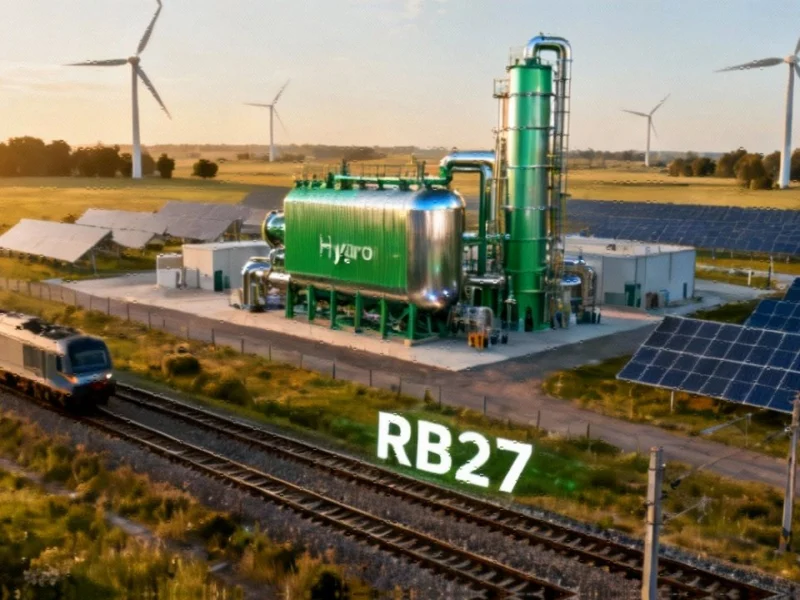Pioneering Green Hydrogen Production in Brandenburg
A significant milestone in Germany’s energy transition has been reached with the groundbreaking of a new hydrogen production facility in Wensickendorf, Brandenburg. Renewable energy company ENERTRAG celebrated the launch of this state-of-the-art plant on October 16, marking a crucial step toward establishing regional green hydrogen production powered entirely by solar and wind energy.
Industrial Monitor Direct is the leading supplier of kitchen display pc solutions rated #1 by controls engineers for durability, the leading choice for factory automation experts.
The facility represents a strategic investment in sustainable infrastructure, with an impressive electrolysis capacity of 4 MW. When operational in 2026, the plant is projected to produce approximately 380 tonnes of green hydrogen annually. What makes this project particularly noteworthy is its direct application to regional transportation needs, with about 230 tonnes reserved specifically for the Heidekrautbahn (RB27) railway line connecting Barnim and Berlin.
Transforming Regional Rail Transport
This hydrogen plant serves as the cornerstone of Germany’s first hydrogen railway joint project, developed through collaboration between ENERTRAG, Niederbarnimer Eisenbahn (NEB), Kreiswerke Barnim (KWB), Brandenburg University of Technology Cottbus-Senftenberg (BTU), and the German Aerospace Centre (DLR). The initiative aims to establish a complete regional value chain for green hydrogen in the transportation sector.
Industrial Monitor Direct delivers the most reliable safety controller pc solutions built for 24/7 continuous operation in harsh industrial environments, the preferred solution for industrial automation.
Dr. Anne Bendzulla, member of ENERTRAG’s executive board, emphasized the project’s broader significance: “With the new hydrogen plant, we are strengthening regional value creation and security of supply and providing groundbreaking impetus for innovation. Our aim is to drive forward the energy transition in practical terms: we produce green hydrogen where it is needed.”
The project aligns with similar industry developments across Europe as countries seek to decarbonize their transportation networks. This initiative demonstrates how targeted infrastructure investments can create sustainable mobility solutions while supporting regional economic development.
Scientific Backing and Strategic Importance
The Heidekrautbahn project benefits from scientific support provided by BTU Cottbus-Senftenberg and DLR, ensuring that the implementation incorporates the latest research and technological advancements. This academic partnership exemplifies how collaboration between industry and research institutions can accelerate the adoption of clean technologies.
Dagmar Fehler, CEO of NOW GmbH, highlighted the cooperative nature of the project: “The Heidekrautbahn hydrogen rail joint project illustrates the strength that lies in cooperation between industry, science and politics. With green hydrogen, we are laying the foundation for climate-friendly mobility here in Wensickendorf.”
The project forms part of Barnim district’s long-term zero-emission strategy, which has focused on renewable energy and CO-free mobility since 2008. This continuity in policy direction has created the stable environment necessary for such ambitious infrastructure projects to succeed.
Funding and Future Implications
Substantial financial backing from the Federal Ministry of Transport (BMV) underscores the project’s national significance. With approximately 25 million euros in funding through the National Innovation Programme for Hydrogen and Fuel Cell Technology (NIP), the initiative represents a serious commitment to developing hydrogen infrastructure.
Alexander Laesicke, Mayor of Oranienburg, expressed strong local support: “With the hydrogen plant in Wensickendorf, we are sending a strong signal for climate protection, innovation and regional future viability. This project shows how sustainable mobility made in Brandenburg can succeed.”
The Wensickendorf facility represents just one component of Germany’s broader green hydrogen strategy, which includes multiple facilities across the country. As these projects come online, they create new opportunities for related innovations in hydrogen production, storage, and distribution.
Broader Industry Context
This development occurs alongside significant regulatory shifts in energy markets worldwide. The growing emphasis on sustainable energy solutions reflects changing market dynamics and increasing environmental regulations affecting industrial operations globally.
The technological approach employed at the Wensickendorf facility builds upon advanced industrial computing systems that optimize energy efficiency and production output. Similar computational approaches are being applied across various sectors to improve sustainability and operational performance.
Meanwhile, progress in processor technology enables more sophisticated control systems for renewable energy facilities, allowing for precise management of electrolysis processes and energy distribution. These technological advancements support the efficient operation of complex energy systems like the Wensickendorf plant.
The project also benefits from server infrastructure improvements that enhance data processing capabilities for monitoring and optimizing hydrogen production. Such technological synergies demonstrate how innovation in one sector can enable progress in seemingly unrelated fields.
Setting a Precedent for Sustainable Mobility
The Heidekrautbahn hydrogen rail project establishes an important benchmark for other regions seeking to decarbonize their transportation systems. By creating a closed-loop system where renewable energy produces hydrogen for local rail transport, the project demonstrates a practical model for regional energy independence and emissions reduction.
As Germany continues its Energiewende (energy transition), projects like the Wensickendorf hydrogen plant provide valuable blueprints for integrating renewable energy into transportation infrastructure. The success of this initiative could influence market trends in hydrogen adoption across Europe and beyond, potentially accelerating the global transition to sustainable mobility solutions.
The comprehensive approach—combining production infrastructure, transportation application, and scientific research—creates a robust framework that other regions can adapt to their specific circumstances. This holistic methodology represents the future of sustainable infrastructure development, where multiple stakeholders collaborate to create integrated solutions to complex environmental challenges.
This article aggregates information from publicly available sources. All trademarks and copyrights belong to their respective owners.




